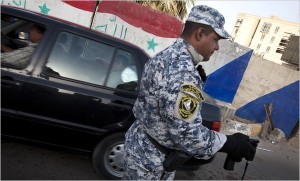
Iraq Swears by Bomb Detector U.S. Sees as Useless
The small hand-held wand, with a telescopic antenna on a swivel, is being used at hundreds of checkpoints in Iraq. But the device works “on the same principle as a Ouija board” — the power of suggestion — said a retired United States Air Force officer, Lt. Col. Hal Bidlack, who described the wand as nothing more than an explosives divining rod.
Still, the Iraqi government has purchased more than 1,500 of the devices, known as the ADE 651, at costs from $16,500 to $60,000 each. Nearly every police checkpoint, and many Iraqi military checkpoints, have one of the devices, which are now normally used in place of physical inspections of vehicles.

Schneier on Security: A blog covering security and security technology November 6, 2009
The Doghouse: ADE 651: A divining rod to find explosives in Iraq:
ATSC’s promotional material claims that its device can find guns, ammunition, drugs, truffles, human bodies and even contraband ivory at distances up to a kilometer, underground, through walls, underwater or even from airplanes three miles high. The device works on “electrostatic magnetic ion attraction,” ATSC says.
To detect materials, the operator puts an array of plastic-coated cardboard cards with bar codes into a holder connected to the wand by a cable. “It would be laughable,” Colonel Bidlack said, “except someone down the street from you is counting on this to keep bombs off the streets.”
Complete quackery, sold by Cumberland Industries:
Still, the Iraqi government has purchased more than 1,500 of the devices, known as the ADE 651, at costs from $16,500 to $60,000 each. Nearly every police checkpoint, and many Iraqi military checkpoints, have one of the devices, which are now normally used in place of physical inspections of vehicles.
Phi Beta Iota: In 1988 when Measurements and Signals Analysis (MASINT) was getting off the ground, we were asked (the Marine Corps Intelligence Center) for our number one requirement. This was it: the ability to detect explosives regardless of the container at a stand off distance of 500 meters. The Israeli solution is a dog on a long leash. There is promising research on living tissues, and on electromagnetic signatures, but generally, given distance as well as a combination of air tight and think multi-material containers, it would take a nuclear probe and this would be similar to the nuclear hand-granade–it kills the users not just the target.



